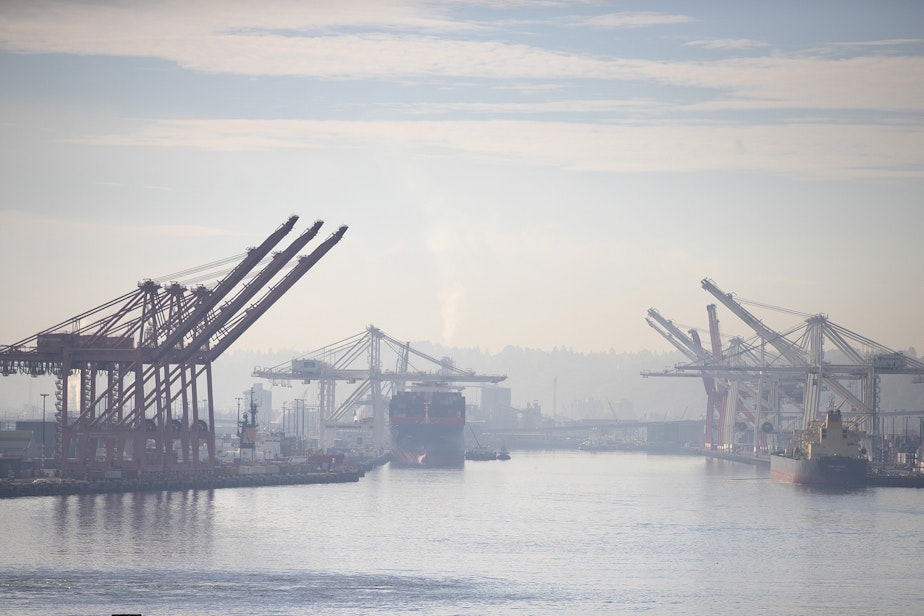Otter dances. Otter poops. Researchers dig in
Three otters gather on a patch of grass on the Green River in Kent.
They waddle. They sniff.
And then two of them do a poop dance.
“We have wonderful footage of what we call the scat dance,” said Michelle Wainstein, a wildlife biologist who studies the droppings of otters along the Green and Duwamish Rivers. "They will do a little prancing with their back feet and lift their tail up a bit and do their thing.”
River otters, adorable as they may be, are top predators that will eat almost any animal they encounter.
“They kind of do this incredible job of sampling the food web for us, and they leave this lovely little package that tells us what is making it all the way up the chain to a top predator,” Wainstein said.
Sponsored
In the Duwamish, downriver from the Green River, what makes it up the food chain is often the highly toxic family of chemicals known as PCBs. This matters beyond the Duwamish: this river is one of the most polluted sources of chinook salmon — the main food of another top predator: the endangered killer whales that roam Puget Sound and beyond.
Scientists study river otters, a much smaller mammal, hoping to understand how to clean up a very dirty river.
Back on the Duwamish, Wainstein combs through the riverside vegetation, looking for the small clearings known as otter latrines, where the furry little swimmers do their business and socialize.
She finds a fresh otter deposit on a grassy mound at the river’s edge. It’s filled with fish bones and scales.
“You can see right there is the lens from a fish eye.”
Sponsored
For decades, PCBs went into transformers and insulation, among other industrial uses. They were banned 40 years ago, but they stick around.
PCBs are a big reason the last five miles of the Duwamish were declared a Superfund site, a national priority for toxic-waste cleanup, in 2001. Signs along the riverbank warn people in eight languages not to eat crabs or most fish from the river. People are told not to eat more than half a pound of chinook salmon per week.
The Environmental Protection Agency says PCB levels in the river’s sediment have fallen by half this decade. Wainstein, the biologist, says otters still carry a heavy burden.
“These otters have very high levels of contaminants in their system,” she said.
Sponsored
River otters are elusive, often nocturnal. Even the people researching them rarely see them. “Otters probably see us more than we see them,” Wainstein said. “We're looking down at our feet because we're looking for poop. We're not looking for otters.”
Wainstein hopes to keep monitoring the otter latrines in the years ahead to see that the Superfund cleanup is getting PCBs out of the ecosystem.
The EPA estimates the cleanup, begun 17 years ago, will take another 19 years.

PCBs build up in orca blubber. When a whale goes hungry, or when it nurses a calf, the stored-up chemicals are released in a concentrated dose. Scientists say orca populations around the world are threatened by PCBs.
Sponsored
Ecotoxicologist Jessica Lundin with the National Oceanic and Atmospheric Administration studies orcas by sampling their poop.
“Samples generally smell like fish that's gone bad," Lundin said. “Imagine you're at the supermarket and the fish doesn't smell quite right.”
Lundin holds up a test tube of orca poop at a NOAA lab in Seattle, with humming spectrometers whirring away to reveal the detailed chemical make-up of animal flesh and poop samples.
The scat processed in this lab has uncovered various problems for orcas, from toxics to the stress of malnutrition.
“Any and all efforts that we can make immediately, near-term efforts, are crucial, crucial to helping this population survive,” Lundin said.
Sponsored
Lundin found one toxic substance in orcas that she wasn’t expecting. A type of chemical called polycyclic aromatic hydrocarbons, or PAHs. They’re found in coal, oil – and in engine exhaust.
“When the whales come to the surface of the water, they take a very deep breath,” she said. “If there is boat exhaust in the air, they very likely may be inhaling some of the exhaust from these motors.”
She got another surprise when she found that PAH levels went down after 2010.
That’s when whale watch boats had to double their distance from whales, from 100 yards to 200 yards. The goal was to reduce disturbance and noise for the orcas. But it had another benefit: orcas breathing less exhaust.
“This is absolutely a bright spot. It is one less exposure that these whales are having to overcome,” she said.
Gov. Jay Inslee’s orca task force released its recommendations for a cleaner, quieter and fishier Salish Sea on Friday.
Now it’s up to elected officials – and everyone else who lives in orca country – to decide what they’re willing to do to help keep orcas around.




